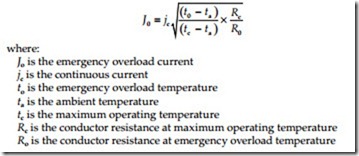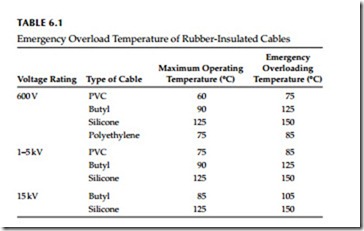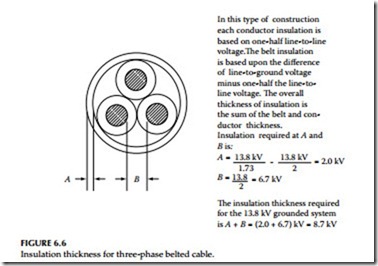Cable Ratings
A basic knowledge of cable ratings is very important in order to select and apply cables for distribution and utilization of power. The following brief description of cable ratings will provide the basis for selecting and applying cables.
Continuous current-carrying rating
The current-carrying capacity of cable is affected by several factors:
1. Maximum allowable temperature
2. Total watt loss (I2Rc) of the cable
3. Ability to dissipate heat
4. Ambient temperature
The maximum conductor temperature is determined by the maximum temperature the insulation system can withstand for extended periods of time without damage. The maximum temperature in turn can be affected by the ability to dissipate heat and the ambient temperature of the medium in which the cable is installed to operate. The sum of ambient temperature and temperature rise in the insulation system should not exceed the total allowable temperature of the conductor for safe operation. Aluminum conductors can be expressed in terms of copper conductors for purposes of current-carrying capacity. The conversion factors to convert the current capacity of the same size aluminum conductor as copper can be expressed in terms of the resis- tance ratio of copper to aluminum, that is, RCu/RAl, where RCu and RAl are, respectively, the resistance of copper and aluminum conductors at rated tem- perature. The effect of temperature on current rating is shown in Figure 6.5. As the temperature of the conductor goes up, so does its resistance. The total loss of the cable is a function of the effective resistance of the conductor at maximum allowable temperature.
Emergency current-carrying rating
The service life of cable is based upon its normal loading limits and normal operating temperature. The normal life expectancy of a cable insulation system is approximately 30 years. However, if the cable system is operated at 5°C–10°C above its temperature rating, it is to be expected that the cable life expectancy will be halved and its average rate of failure doubled. Another disadvantage in operating cables over their temperature rating is that copper loss is directly proportional to the square of current and resistance.
Furthermore, because of increased resistance and current, the voltage drop may be excessive and may jeopardize equipment and service continuity. Any program to operate the cables beyond the limit of their current and tempera ture ratings must be judiciously undertaken. To calculate the emergency rating of cables, the following formula may be used:
Overloading should be less than 100 h/year. Rubber-insulated cables may be operated at overloading temperature in accordance with Table 6.1.
Voltage rating
The voltage ratings of cables are specified as the line-to-line voltage that they can withstand. However, the insulation thickness is based upon line-to-ground voltage. To specify the system voltage for procurement and installation of cables is not sufficient. It is necessary to specify also the type of system that the cable will use. Assume a cable application on a grounded 15 kV system, for which the insulation will be based upon line-to-ground voltage, that is 15/1.73 = 8.66 kV. Whereas on a 15 kV ungrounded system, the insulation thickness will be based on 15 kV because that is the voltage imposed on unfaulted conductors. The basis for voltage thickness for 15 kV belted cable operating at 13.8 kV grounded system is illustrated in Figure 6.6.
Short-circuit rating All cable systems have thermal limitations, which are specified in terms of short-circuit withstand temperatures and current ratings. Under a short-
circuit condition, the temperature of the conductor rises very rapidly. If the conductor is not sized to withstand the available short-circuit current, it will melt, resulting in cable failure. Because of the insulation sheath surrounding the conductor and its characteristics, it will cool off very slowly after the fault has been removed. The temperatures shown in Table 6.1 should not be exceeded per standards of the Insulated Cable Engineering Association (ICEA) for more than 10 s. Cable manufacturers publish current-withstand
ratings for all sizes of conductors. The NEC requires that systems should be designed to have full withstand capability. Every cable installation should be checked for short-circuit withstand rating; otherwise, severe damage or
complete failure may result. Failure may be accompanied by fire and smoke, thus resulting in danger to personnel and property. Also, because of thermal expansion due to intense heat under short-circuit conditions, the cable may be permanently damaged if not correctly selected for this purpose.



